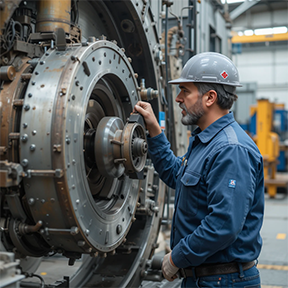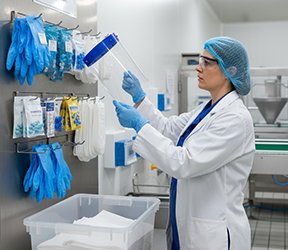Published: November 05, 2025 | Updated: October 31, 2025
Published: November 05, 2025 | Updated: October 31, 2025
How CMMS Safety Strategies Reduce Downtime and Improve Workplace Reliability
 The principle of safety-first maintenance strategies with CMMS support applies across industries. Downtime, whether caused by equipment breakdowns or safety incidents, disrupts productivity and drains resources. Preventive maintenance reduces these risks, and modern tools like a computerized maintenance management system (CMMS) enhance the process. By blending proactive inspections with digital management, organizations can create safer environments and more reliable operations.
The principle of safety-first maintenance strategies with CMMS support applies across industries. Downtime, whether caused by equipment breakdowns or safety incidents, disrupts productivity and drains resources. Preventive maintenance reduces these risks, and modern tools like a computerized maintenance management system (CMMS) enhance the process. By blending proactive inspections with digital management, organizations can create safer environments and more reliable operations.
The Hidden Costs of Downtime and How CMMS Prevents Them
Downtime extends beyond broken machines. A production line may halt because a conveyor motor fails, but operations can also stop when employees face injuries or unsafe conditions. For example, in the food processing industry, a slip caused by an unaddressed spill can pause work in an entire area while safety teams respond. Both scenarios waste time, increase costs, and damage trust with customers.
A CMMS addresses these risks by tracking incidents, scheduling inspections, and recording safety checks. Managers gain visibility into the causes of downtime and can act before small problems escalate.
Preventive Maintenance Programs in Action
Preventive maintenance sets the foundation for workplace safety. Consider a manufacturing plant with heavy machinery. Without routine lubrication, inspections, and part replacements, critical components fail. A CMMS enables managers to set recurring schedules, monitor progress, and document completed work orders.
Industries such as utilities or transportation also rely on preventive maintenance. A power company, for instance, must regularly service transformers and circuit breakers to prevent outages and protect crews. By using a CMMS, the company ensures inspections occur on time, issues receive immediate attention, and historical data informs future planning.
Safety Inspections and CMMS Tracking That Prevent Hazards
Regular inspections uncover risks before they cause harm. Common items include worn belts, loose bolts, exposed wiring, or blocked exits. In the warehousing sector, forklift inspections detect faulty brakes or failing warning lights that might otherwise cause collisions.
A CMMS centralizes inspection data. Supervisors can generate digital checklists, assign tasks, and ensure completion. When workers log inspection notes into the CMMS, managers receive real-time alerts about hazards, reducing delays between identification and correction.
Electrical Safety Strategies for Downtime Prevention
Electrical failures often result in fires, equipment damage, or severe injuries. For example, in commercial kitchens, faulty wiring can ignite grease-laden air ducts. Routine inspections of outlets, breakers, and cables reduce the chance of such incidents.
A CMMS supports electrical safety by keeping maintenance records organized. MAPCON’s CMMS can track inspection frequency, document repairs, and provide reminders when regulatory standards require testing. By digitizing records, companies avoid the risks of overlooked or outdated paper logs.
Discover how streamlined maintenance processes can elevate production. Learn more.
Chemical Storage and Handling
Chemical hazards appear in laboratories, manufacturing plants, and even janitorial supply rooms. Inadequate labeling or deteriorating containers can trigger spills, contamination, or toxic exposure. For instance, a pharmaceutical plant must carefully manage flammable solvents in climate-controlled storage.
A CMMS assists by cataloging storage inspections, assigning corrective actions, and archiving compliance reports. When regulators request documentation, companies can easily produce digital records. This transparency helps avoid fines and maintains safer work conditions.
Preventing Slips, Trips, and Falls with CMMS Safety Tools
In the retail sector, a simple water spill on a tile floor may lead to a serious injury and legal claims. In construction, uneven surfaces or cluttered walkways increase fall risks. Preventing these hazards requires vigilance and frequent inspections.
With a CMMS, supervisors can schedule routine floor checks, document cleanup responses, and verify that high-traffic zones remain clear. Automated reminders ensure no inspection lapses, even during busy operations.
Fire Safety as a Non-Negotiable
Industries such as warehousing and hospitality face significant fire risks. In storage facilities packed with flammable materials, a malfunctioning sprinkler system can devastate entire inventories. Hotels must maintain fire alarms and evacuation signage to safeguard guests and staff.
A CMMS simplifies fire safety management. MAPCON’s system, for instance, allows recurring fire extinguisher checks, generates reminders for sprinkler inspections, and tracks fire drill participation. Detailed reporting demonstrates compliance with fire codes and reduces liability.
Workplace Air Quality and Ventilation Maintenance Using CMMS
Poor ventilation affects industries ranging from automotive shops to office environments. In welding shops, fumes accumulate quickly without proper exhaust systems. In office buildings, dirty HVAC filters trigger allergies, fatigue, and sick days.
A CMMS tracks filter replacement schedules, monitors system inspections, and generates alerts when readings fall outside acceptable ranges. Consistent air quality management protects both employees and productivity.
Ergonomics and Workplace Comfort
Repetitive strain injuries cost employers billions annually. In logistics centers, constant lifting leads to back injuries. In offices, poorly arranged workstations cause wrist or neck strain.
A CMMS adds value by logging ergonomic assessments and scheduling workstation evaluations. When adjustments occur—such as installing sit-stand desks or ergonomic chairs—records in the CMMS provide accountability and help track effectiveness.
Vehicle and Fleet Safety
Transportation companies and construction firms rely heavily on vehicle safety. A delivery truck with worn brakes risks both driver safety and delivery schedules. Heavy machinery on construction sites requires constant monitoring to avoid catastrophic accidents.
A CMMS supports vehicle fleets by managing preventive maintenance schedules, tracking mileage, and monitoring repairs. It even allows managers to receive alerts when critical thresholds, such as brake wear, approach unsafe levels.
 PPE serves industries ranging from healthcare to manufacturing. In food production, hairnets, gloves, and aprons prevent contamination. In metalworking, goggles, gloves, and ear protection reduce injury risks.
PPE serves industries ranging from healthcare to manufacturing. In food production, hairnets, gloves, and aprons prevent contamination. In metalworking, goggles, gloves, and ear protection reduce injury risks.
A CMMS helps maintain PPE inventory by tracking usage rates, monitoring expiration dates, and ensuring stock availability. This prevents shortages and guarantees employees always have the protective gear they need.
Building a Workplace Safety Culture with CMMS Preventive Tools
Safety extends beyond inspections and tools—it requires culture. Organizations in every sector thrive when employees view safety as part of daily work rather than an afterthought. From oil refineries to hospitals, creating a proactive culture reduces accidents and enhances morale.
A CMMS reinforces this culture by embedding safety practices into daily workflows. Automated reminders, digital checklists, and accountability measures encourage consistent compliance. Managers gain visibility into safety performance, while employees feel supported by structured processes.
The Future of CMMS Safety and Proactive Downtime Prevention
Safety-first maintenance creates more than compliance—it fosters reliability, productivity, and trust. Across industries, a CMMS strengthens these efforts by organizing tasks, tracking hazards, and supporting preventive strategies. With technology driving daily safety practices, companies reduce downtime and protect their most valuable resource: people.
FAQs
What is a CMMS and how does it help with workplace safety?
A CMMS, or computerized maintenance management system, helps track inspections, schedule preventive maintenance, and reduce hazards.
How can regular maintenance reduce downtime?
Routine maintenance identifies problems early and prevents unexpected breakdowns that halt production.
What workplace areas need the most frequent safety inspections?
High-risk areas include electrical systems, equipment with moving parts, chemical storage rooms, and heavily used walkways.
How does MAPCON’s CMMS support preventive maintenance?
MAPCON’s CMMS schedules tasks, tracks work orders, and provides historical data to keep equipment safe and reliable.
Why is personal protective equipment (PPE) important in maintenance?
PPE protects workers from hazards that cannot be eliminated through equipment design or engineering controls.
How often should fire safety equipment be checked?
Fire extinguishers, alarms, and sprinklers should be inspected regularly, typically every month and annually by professionals.
MAPCON | 800-922-4336
MAPCON CMMS software empowers you to plan and execute PM tasks flawlessly, thanks to its wealth of features and customizable options. Want to see it for yourself? Click the button below to get your FREE 30-day trial of MAPCON!
Try It FREE!
{
"@context": "https://schema.org",
"@type": "FAQPage",
"mainEntity": [
{
"@type": "Question",
"name": "What is a CMMS and how does it help with workplace safety?",
"acceptedAnswer": {
"@type": "Answer",
"text": "A CMMS, or computerized maintenance management system, helps track inspections, schedule preventive maintenance, and reduce hazards."
}
},
{
"@type": "Question",
"name": "How can regular maintenance reduce downtime?",
"acceptedAnswer": {
"@type": "Answer",
"text": "Routine maintenance identifies problems early and prevents unexpected breakdowns that halt production."
}
},
{
"@type": "Question",
"name": "What workplace areas need the most frequent safety inspections?",
"acceptedAnswer": {
"@type": "Answer",
"text": "High-risk areas include electrical systems, equipment with moving parts, chemical storage rooms, and heavily used walkways."
}
},
{
"@type": "Question",
"name": "How does MAPCON’s CMMS support preventive maintenance?",
"acceptedAnswer": {
"@type": "Answer",
"text": "MAPCON’s CMMS schedules tasks, tracks work orders, and provides historical data to keep equipment safe and reliable."
}
},
{
"@type": "Question",
"name": "Why is personal protective equipment (PPE) important in maintenance?",
"acceptedAnswer": {
"@type": "Answer",
"text": "PPE protects workers from hazards that cannot be eliminated through equipment design or engineering controls."
}
},
{
"@type": "Question",
"name": "How often should fire safety equipment be checked?",
"acceptedAnswer": {
"@type": "Answer",
"text": "Fire extinguishers, alarms, and sprinklers should be inspected regularly, typically every month and annually by professionals."
}
}
]
}